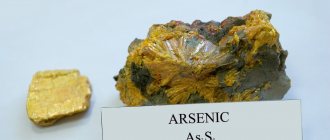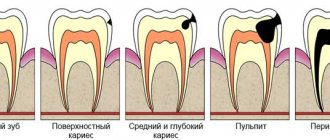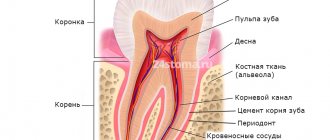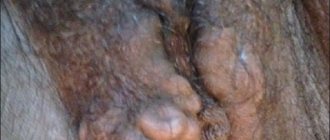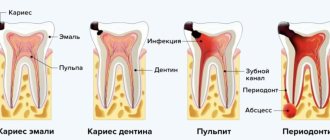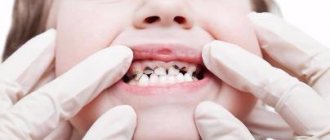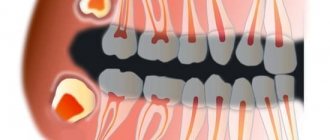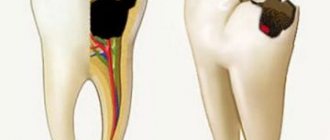Tooth nerve and need for removal
A tooth is not just a bone. In its roots there is a living pulp - blood vessels with nerve endings. This pulp is called the dental nerve; with its help, the tooth senses heat or cold. If the pulp is removed, the tooth dies, is not supplied with blood, is easily destroyed, and is less resistant to influence.
If a tooth is affected by caries, at first the destruction involves only dentin, the durable tissue of the tooth. But if caries is not treated in a timely manner, it will reach the pulp and pulpitis will begin. Then the pulp has to be removed - completely or partially, and if the pulpitis has reached periodontitis, the pulp has to be completely amputated. The nerve is also removed in case of mechanical destruction or prolonged pain.
Contraindications
The following conditions are contraindications for the use of arsenic-based drugs:
- children's age up to 1.5 years;
- allergy to arsenic and its components;
- lack of fully formed roots or reabsorbing roots;
- when it is impossible to completely clean the canals (their curvature, fusion, blocking with tartar);
- artificial hole in the root (disconnection or perforation);
- high eye pressure (threat of glaucoma);
- not completely sanitized and cleaned channels;
- diseases of the urinary organs;
- state of pregnancy or breastfeeding.
The use of arsenic paste is not allowed for pregnant women and nursing mothers. In these situations, even the minimum content of poison can be unpredictable and toxic for the child’s body.
The use of arsenic is also undesirable for children. They often break the temporary filling themselves, and the toxic medicine enters the body. This can cause intoxication of the delicate child's body.
Arsenic is still commonly used by dentists. And its use can be very justified. An experienced doctor using this medicine has successfully relieved hundreds of patients from unbearable pain. The main thing is to cure the tooth without unnecessary suffering and not spoil your health. Take care of yourself and smile more often!
Sources used:
- Knizhnikov V.A., Bochkarev V.V., Zimina L.N., Marchenko E.N., Rubtsov A.F., Serebryakov L.A. Arsenic // Big Medical Encyclopedia
- Anesthesia in dentistry / S.F. Gritsuk. - M.: Medical Information Agency (MIA), 1998.
- Therapeutic dentistry. National leadership / L.A. Dmitrieva. - M.: GEOTAR-Media, 2015.
Removal with arsenic
Once upon a time there was only one way to remove it, it was terribly painful, especially since you had to visit the doctor several times. At first, the doctor drilled the tooth down to the pulp with a drill, which was extremely painful. Next, arsenic was placed in the hole and it was temporarily sealed with a filling. In a couple of days, the arsenic dealt with the nerve, and the tooth hurt so much that no medicine could help. Then I had to go to the doctor again, he opened the temporary filling, removed the nerve, and cleaned the root canals. Pulp is a tenacious substance, so this process was also extremely painful.
This technology poses a certain danger, because arsenic is a poison, and the doctor, when using it, must be especially careful, and the patient must be careful: if you are late with the second visit to the doctor and leave arsenic in the tooth, it will completely destroy it, which will end deletion. Dentists stopped using arsenic and developed new techniques for removing pulp.
How long can an adult keep arsenic in a tooth?
Depulpation of a dental element is a procedure that allows you to kill a painful nerve that worries the patient. This manipulation requires the use of special painkillers, one of which is arsenic. To necrotize the dental nerve, arsenic paste is placed into the canal. To achieve the desired effect, the product must be kept for a certain time. Therefore, it is very important to know how much arsenic should be kept in the dental element.
Use in dentistry Arsenic paste is used in the treatment of pulpitis for the purpose of analgesic effects on the pulp. However, in this case there are indications and contraindications.
Arsenic must be used:
when a patient may have an allergic reaction to an anesthetic drug;
if the anesthetic drug used does not have the maximum effect;
there is not enough time for the anesthetic drug to take effect;
if the patient has recently suffered a heart attack;
the patient has hypertension;
the patient is under the influence of alcohol. Contraindications:
when the patient has an allergic reaction to arsenic or anesthetic drugs that contain arsenic;
if a child under three years old needs dental treatment;
tooth roots are not sufficiently formed;
if the patient is diagnosed with glaucoma;
when the patient has pathologies of the genitourinary system;
perforation of the roots of dental elements was diagnosed. Stages of treatment
The initiation of therapy must necessarily begin with an examination using an x-ray. Then, if the pathology is confirmed, the specialist opens the carious cavity and removes dead tissue. Arsenic paste is placed into the cleaned channel. The final steps include filling the dental element with a temporary filling. The doctor determines the duration of arsenic exposure. The second visit is characterized by the removal of arsenic from the tooth and the dead nerve is removed. This manipulation is absolutely painless.
How long should you keep arsenic paste in your tooth?
It is very important to determine how much arsenic should be kept. There are a lot of criteria here - the patient’s age, the drug used, pulp indicators (the drug is placed on a closed pulp or an open one). The average duration of exposure to arsenic on a nerve is 1 day. If multiple treatments are necessary, the doctor will increase the duration of action to two days. If we are talking about the treatment of dental elements of children, then the extraction of arsenic should occur no later than 16 hours later.
Attention! There are modern medicines that contain arsenic. Their effect on the diseased nerve can be increased to five days. Recommendations
Since arsenic paste is poisonous, safety rules must be followed. It is important to come to your next appointment at the time agreed with your doctor. First of all, follow this list of rules:
1) Maintain the integrity of the temporary filling. Initially, the filling is made airtight, so arsenic acts exclusively on the diseased nerve. If the integrity of the filling is damaged, arsenic comes out and affects the surrounding tissues. As a result, an inflammatory process occurs, which is accompanied by painful sensations.
2) Do not exceed the period of exposure to arsenic.
3) The specialist should not make a mistake with the dosage of the product.
What to do if you experience discomfort? Often the patient may experience discomfort when exposed to arsenic, to minimize anxiety, it is recommended:
rinse your mouth with soda solution if there is a sour taste. In this way, the acidic effect can be neutralized and burns can be avoided; after arsenic is introduced into the tooth, pain may occur; a glass of warm milk will be required to relieve it. To do this, hold the milk in your mouth for a few seconds, and then drink the drink completely.
Reference! Milk, namely the protein it contains, quickly removes arsenic from the body. How harmful is arsenic?
Since this product is a type of poison, it is used for dental purposes in minimal dosages, with strict adherence to safety rules. Proper use of arsenic minimizes harmful effects.
If the timing of exposure to arsenic is violated, it can penetrate the tissue structure, accumulate there and cause complications. If some of the arsenic gets into the oral cavity, then a protracted inflammatory process should be expected.
With incorrect dosages of arsenic, the following consequences are observed: 1) Dentin begins to blacken.
2) Swelling and inflammation of the pulp occurs.
3) Toxic effects on the body.
4) Inflammatory process of periodontal tissue.
5) Osteonecrosis.
Very often, the patient may ignore the deadlines indicated by the specialist. As a result, arsenic periodontitis occurs, the treatment of which requires a long time. When exposed to arsenic, tissue necrosis cannot be ruled out. If the patient experiences increased sensitivity, toxic damage to the intestines and liver subsequently occurs. Arsenic extraction process
In the depulpation procedure, it is very important to remove arsenic in a timely manner. If you ignore this indicator, you can get the above complications.
Advice! When the patient is unable to visit the doctor at the appointed time, the arsenic must be extracted independently. To do this, wash your hands and disinfect them in advance. Then break the integrity of the seal and remove the arsenic. The danger of manipulation is that it can be swallowed. Therefore, procedures should be carried out with extreme caution. Upon completion of the manipulation, the oral cavity must be rinsed with a soda solution. In this case, visit the dentist as soon as possible. Use of arsenic for pregnant women
If a woman is a nursing mother or is pregnant, then the use of products containing arsenic is strictly prohibited. This is due to the toxic effect on the baby. When a woman is short of pregnancy, it is important to warn the dentist about the situation. Modern dentistry is rich in safer medications that are approved for use by pregnant women. It is important! Additionally, auxiliary substances can be added to the paste, which are necessary for preparing a small dose.
The patient must remember that in no case should the duration of exposure to arsenic on the diseased nerve be exceeded, because this is fraught with dangerous consequences.
Dental treatment at the AVANTA dental clinic in St. Petersburg. Our specialists will conduct an initial examination and advise you. We are located next to the Mezhdunarodnaya metro station, at the address: Frunzensky district, Bela Kun street, building 2, building 1.
#dental treatment #dentistry
Modern pulp removal
Today, it is enough to go to the dentist once to remove the pulp. The doctor gives an anesthetic injection and calmly works with the tooth, removing the destroyed layer of dentin, extracting the pulp, treating and filling the canal. Sometimes inspection using a microscope is possible. To be on the safe side, your doctor may place a filling temporarily to make sure he has completely removed the pulp. And only if everything turns out to be in order, the final filling is installed.
Incomplete removal of the pulp is also possible, which makes sense if only the outer part of the pulp is affected by inflammation. Dead tissue is removed from the opened tooth, the outermost part of the pulp is removed, and the root remains intact. This is especially important on children's teeth, since the pulp is responsible for the formation of roots. When the pulp is not completely removed, the tooth is kept alive, and further destruction occurs more slowly.
Life time
The service life of a temporary filling varies from 3-4 days to 2-3 weeks. The exact timing depends on the specific dental disease and the drugs used in treatment.
Here's how much a temporary filling can cost in different situations:
- when using arsenic paste to kill a diseased nerve - no more than 2-3 days (usually 24-28 hours), when using other means (for example, paraform paste) for the same purposes - 5-10 days;
- when using antibiotics and antiseptics in the treatment of deep caries or pulpitis - from 3-4 days to 2-3 weeks;
- in particularly complex diagnostic cases – up to 3 and even 6 months.
If you can’t get to the doctor on time, be sure to notify him in advance. In this case, if possible, he will try to place the most durable reflective filling that can be safely worn for several months.
Why does a tooth from which the nerve has been removed hurt?
Patients often complain that the tooth from which the nerve was removed continues to hurt. This is a completely natural pain, the result of intervention in the body. In a couple of days the pain will go away. It can be observed when clenching teeth, when reacting to hot and cold. To reduce discomfort, take analgesic medications.
But if, due to improper treatment, the nerve was not completely removed, the pain and inflammation will return. It is possible that the canals were poorly treated, and there may also be an allergy to the filling material. It is necessary to go to the doctor immediately, since advanced inflammation can lead to tooth loss.
The tooth from which the nerve has been removed becomes dead, but it still remains and is not lost, so if you have a toothache, immediately go to the dentist. There is nothing to be afraid of - modern treatment is painless, and after it your diseased tooth will serve you for many years to come.
Indications
Let's figure out when the use of arsenic is acceptable and justified. Most often, arsenic paste is used when it is not possible to use other analgesics. This substance is used to kill nerve endings and blood vessels in the pulp. Arsenic paste can be used in the following situations:
- it is impossible to use another type of anesthesia due to the patient’s health condition (high blood pressure, alcohol intoxication);
- urgent emergency treatment and absence of other anesthetics;
- allergy to other painkillers;
- lack of effectiveness of other anesthetic drugs due to the patient’s high pain threshold;
- when treating baby teeth in children, when local anesthesia cannot be performed (the child is afraid of injections).
When is it necessary to remove a nerve?
Dentists are trying their best to save the tooth, but, unfortunately, this is not always possible. For example, in case of extensive caries, it is necessary to resort to removing the nerve of the tooth. The nerve (pulp) is responsible for the sensitivity of the unit. Pain and other unpleasant symptoms arise precisely because of inflammation of the pulp. The following conditions are considered the main indications:
- Advanced periodontitis.
- Deep caries affecting the internal tissues of the tooth.
- Acute pulpitis.
Also, this manipulation is indicated in cases where crowns, bridges, veneers and other fixed prostheses are to be installed. First of all, this is done with the intention that the tooth does not get sick under the artificial structure. In this case, the unit is considered dead, but continues to perform its functional duties.

